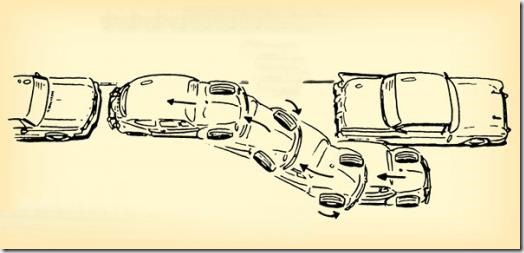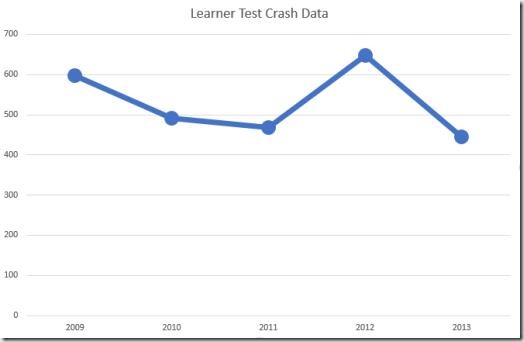I get a lot of hits from people asking about parallel parking, so I’m going to write a How To… article on the subject to go along with the others. This article isn’t it – it’s just a bit of a discussion.
In my own experience, I’ve found that the manoeuvre pupils seem to have the most trouble with is reversing around a corner. I suspect that this is down to the fact that, unlike the others, you have to remain in control with precise adjustments throughout. However, before they’ve actually had a go, most pupils will identify parking – parallel parking, in particular – as the “most difficult”. I love to watch the look on their faces the first time I tell them that’s what we’re going to do today, but the look once they see how easy it is even better.
Parallel parking amounts to the same thing whatever method you use – the driver has to reverse into a space following a sort of backwards “S” shaped path. Any subsequent farting about comes as a result of not following that path properly, and that’s usually because the method they used isn’t very good.
Here’s a true story. Earlier this year one of my serial failers got the parallel park manoeuvre on three of her four tests (including the one she eventually passed on). It was the source of a serious fault on two of them, and the reason for that was that she had absolutely insisted on using the method her previous instructor had taught her, even though it only worked about 50% of the time. Her method involved estimating the position of the kerb (which could easily vary by ½ a metre or more), and some other nonsense about putting on one turn of the wheel, “lining up with the rear lights” on the target car, and then turning one turn the other way (this went tits up on one test because the target car was facing the other way and she couldn’t see its lights). After her last fail – amidst the tears – I put my foot down and told her she was learning MY method or nothing. As I say, she got the same manoeuvre the next time, and passed.
Whenever I pick up a new pupil who has covered the parallel park elsewhere I give them a chance to show me how they do it. If they can remember how to do it at all – and many can’t – they usually end up either too far back or too far away from the kerb. Having said that, if any of them can achieve a satisfactory result using their own method, I’ll let them carry on using it – but I can count on the fingers of one hand the number of times that’s happened. As long as I live, I will never understand why someone would teach pupils to reverse beyond the end of the target car, but only to apply partial lock (it’s usually “one turn”) and expect to finish within the requisite two car lengths. I’ll also never understand why someone would teach a method to a beginner which depends on how well the target car is parked, and which involves guessing where the kerb is. And don’t get me started on the problems that arise when the target vehicle is a lorry or stretch limo – try lining up diagonally with the lights and see how good the method is then!
You see, the problem stems from the fact that people who have been driving for years – and this includes a lot of instructors – have something that learners don’t. It’s called “experience”. Experience means many things, but one aspect of it is that “guessing” where the kerb is becomes slightly easier for more experienced drivers, whereas a beginner won’t have a clue – and nor will many of them be likely to acquire one by taking a couple of hours of driving lessons a week. However, let’s not deceive ourselves here. I said slightly easier, and if watching “experienced” people trying to park outside the local shops is anything to go by, this just means that there’s a marginally reduced risk of them flattening a passer-by or altering their bumper trim against street furniture. It certainly doesn’t make them parking experts.
Something else to consider is that an “experienced” driver can arse about for as long as they want until they eventually manage to park, or their conscience kicks in and they drive off to find somewhere else. It doesn’t matter if they hit the kerb or finish on it, take up two spaces, or end up diagonally with their back end sticking a metre into the road (well, not unless the council’s traffic Gestapo have been told to crack down on it at the time). In most cases, they will have the social conscience of a dog on a croquet lawn, and they won’t give a toss about how much inconvenience they are causing for everyone else (that’s another aspect of “experience”). A learner, on the other hand, is typically 17 years old, shy, nervous, has an examiner sitting next to them, and has basically got one shot at doing it perfectly in order to gain the shiny new driving licence on which their future depends. The two situations are not even in the same ball park.
For this reason, a learner needs a method that is as fool proof as possible, and not some Zen-like nonsense that fails as often as it succeeds.
The driving test is only the first step in learning to drive. Passing it means you are deemed safe to go out and gain more experience by practicing and consolidating what you learnt on your lessons. The first time you go out on your own it will be a new experience, but the second time it won’t be. The more you go out, the more confident you will become. Exactly the same thing applies to something like parallel park, where the first time you try it for real you’ll be nervous, but you will learn from it and begin to develop your own system. That’s how it has always been.

 Well done to Anna, who passed today first time with just 5 driver faults. I really wish all my pupils were like her – she was a fast learner, anxious to be a safe driver, and very pleasant with it all. As I said to her more than once, she was easily capable of passing, even though as we got closer to her test her nerves did start to kick in a little. But it didn’t matter in the end, and she has a car all lined up.
Well done to Anna, who passed today first time with just 5 driver faults. I really wish all my pupils were like her – she was a fast learner, anxious to be a safe driver, and very pleasant with it all. As I said to her more than once, she was easily capable of passing, even though as we got closer to her test her nerves did start to kick in a little. But it didn’t matter in the end, and she has a car all lined up. Well done to Ian, who passed on Monday first time with 11 driver faults. He’s been a nice guy to teach, although his repeated “is this on the test route?” questions were a little tedious sometimes. As I pointed out frequently to him, if you can drive it doesn’t matter where we do the lessons, and I will show you any tricky features!
Well done to Ian, who passed on Monday first time with 11 driver faults. He’s been a nice guy to teach, although his repeated “is this on the test route?” questions were a little tedious sometimes. As I pointed out frequently to him, if you can drive it doesn’t matter where we do the lessons, and I will show you any tricky features! Well done to Duncan, who passed first time (with me) today with 8 driver faults. He told me that if he’d have failed this time – having taken his test four times several years ago – he was going to give up. To be honest, he was one of those who I’d have put money on passing, so I’ve no idea what he was thinking to coming up with something like that, but as they saying goes, there’s nowt so queer as folk.
Well done to Duncan, who passed first time (with me) today with 8 driver faults. He told me that if he’d have failed this time – having taken his test four times several years ago – he was going to give up. To be honest, he was one of those who I’d have put money on passing, so I’ve no idea what he was thinking to coming up with something like that, but as they saying goes, there’s nowt so queer as folk.